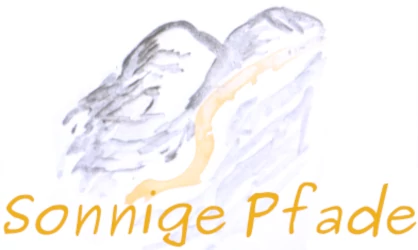
Another „century – summer“ lies behind us. The paralyzing heat is over, the constant sunny days unfortunately also. What we are left with is the drought, even if just a few miserable thin showers spread some freshness over the dry ground of the Dahlener Heide.
[contains references to gastronomy, shops, leisure facilities etc. and therefore it is advertising]
Weekend adventure near Leipzig – visit the Schildbürger
Nevertheless – especially this autumn time is good enough for short adventures – little escapes from everyday life. A destination for weekends, or even just for a day, is in the east, accessible from Leipzig or Halle – the Dahlener Heide (Dahlen heathland) and the Schilda(u) Citizens, the Schildbürger. (The german „Schildbuerger“ are comparable with „The wise men of Gotham“ in UK)
As the Dahlener Heide is a hilly area without steep climbs (the Schildberg is the highest elevation at 217m), older people or families with small children can also experience this area without too much sporting challenge. However, a large part of the paths are forest and field paths only with split fillings, so wide bicycle tyres are recommended. The northern route recommended here as a cycling tour leads from the Leipzig suburban train via Schildau to Belgern.
The weather in Schildau and the Dahlener Heide today.
Arrival with S-Bahn and bike
You can take the Leipzig suburban train S4 (the long northern branch with the distant destination Hoyerswerda) from Leipzig to Doberschütz. The people from Halle, who come via Delitzsch, take the S4 in Eilenburg and then only have two stations left. Luckily, the MDV (the public transport association) offers free bike transport on its rail connections, so you can bring your own bikes with you.
With bike rental stations, things still look pretty bleak in the area. And without a bike you are stuck in Doberschütz, unless you are interested in long walks.
You don’t need to cycle into the village, the only thing that gets on your nerves is the B87 with all the car-trippers. It’s better to take the road in the opposite direction and then turn left into the dirt road and head for Strelln and Schöna. The first destination should be recognizable in the distance – the Schildberg near Schildau with a small hump on the hilltop, which makes the tower visible. (about 14,5km) ( Cycle path to Schildberg: https://t1p.de/y06z )
First stage over fields to Schildberg
At first, the route takes you over dirt roads through open landscapes. From Strelln there are municipal roads, all of them very little used and, except for a few narrow curves between Schöna and Kobershain, very clear.
A small tip for overnight stays: the old Kobershain manor house now has a castle hotel with a family suite and double rooms*. From here, Schildberg-forrest and the town of Schildau are also very easy for children to reach by bike.
From Kobershain there are two possible routes to the Schildberg. One leads about 1.5 km along the road in the direction of Schildau and then turns right into a forest path, the other one already in Kobershain on ascending paths and past the windmill.
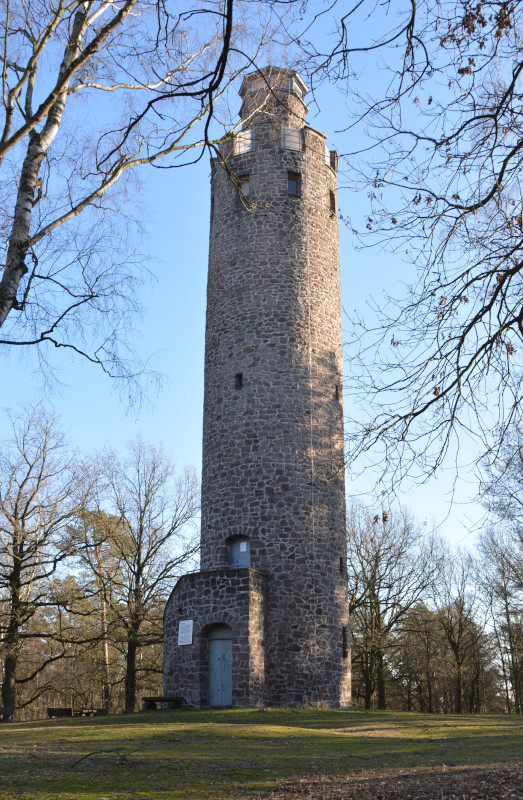
There is some speculation about the name of the Mount Schildberg. Some believe it comes from the shape of a flat lying shield. More probable is the assignment to the small town Schildau, to whose grounds the Schildberg forest belongs. In some maps the name „Schildauer Berg“ is consequently also mentioned, although no local says so.
Schildberg- view and hidden gems
The Schildberg is a porphyry hump with a height of 217m above sea level, which finds a continuation in the Hohburg mountains in western direction. On top there is a stone tower, which is used by the forest as a fire watch tower in case of forest fire danger (meanwhile by video technology). Under this pulpit is a viewing platform. This is open at weekends during the summer season, if there is not too much danger of forest fire.
From the height you can enjoy a wide panoramic view: to the northwest you can see the radio tower Roitzsch in the Dübener Heide. In northern direction you can see the castle Hartenfels in Torgau. To the east are mainly the wooded areas of the Dahlener Heide. If your gaze does not wander that far, you will see Schildau below the mountain with the striking town church and the town hall to the left.
Southeast in the distance another mountain – the Collm near Oschatz, with good visibility a radio tower and an old stone tower is to be recognized. Possibly even a white building below the summit – this is the observatory Collm. In southwest direction the Hohburg mountains lie. If the weather and the position of the sun allows it, you might even recognize Leipzig with the „Weißheitszahn“ (former university high-rise, now mdr building) and the Monument of the Battle of the Nations.
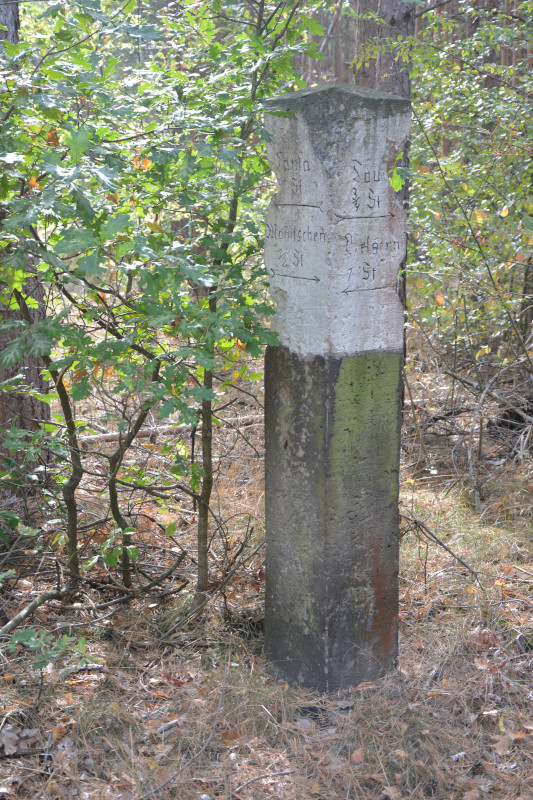
Unfortunately, after the raging of the storm „Friederike“ in winter 2018, the forest has been severely damaged by the second successive summer drought and heavy bark beetle infestation. This can be seen particularly clearly from above at the many brown tree tops. In the next few years, great efforts will be required from foresters to promote the conversion of the forest into more resistant mixed deciduous forests.
On the trail of history
The Schildberg Tower was built in the 1930s by „Kraft – durch – Freude“ (Power – through – Joy) missions, a Nazi organization. Actually a kind of Thing-Place should be built at the Schildberg with open-air theatre on the slope etc. But from 1939 on the power was no longer used for joy, but for warfare, so the original plans for after the final victory were postponed. The forces who then took over were friends of other joys and so the building plans were finished.
If you leave the Schildberg – Plateau on the descent to the south, there is a path to the right after about 50m. There it goes to the „Napoleon stone„. This is a rock hump, which rises from the forest floor on the western slope of the Schildberg (with one of the smallest boofen of Saxony 🙂 . Napoleon is said to have camped there on the eve of the Battle of Nations in 1813. The path there also leads above a quarry (the „Heßler-Schlucht“ Gorge). This is now a small nature reserve with sunny walls and a wetland biotope.
Another quarry (and not the only one) is located about 500m further south. This one is „flooded“, i.e. largely filled with water.
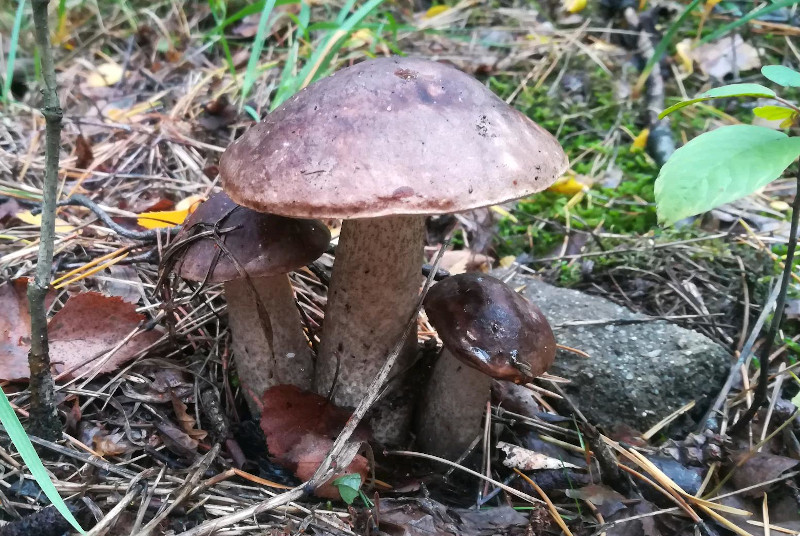
Country division after the Battle of the Nations and the Congress of Vienna
The road connecting the quarries is today the district border between North Saxony and the Leipziger Land and was the border between the diminished Kingdom of Saxony and the Kingdom of Prussia after the Congress of Vienna in 1815. Saxony had allied itself with the Battle of the Nations – loser Napoleon and had not only to leave feathers but also to cede some square kilometres of land to the victors. South of the Schildberg and Schildau and across the Dahlener Heide, the boundary stones with the markings KP and KS (Kingdom of Prussia and Kingdom of Saxony) can be found again and again.
A visit to the Schildbürger
(Schildbürger = Schildau citizens, there are some tales about … look down for more)
From the Schildberg several paths now lead to Schildau. All of them have their charm, but I would not stay on the border path, because it does not lead directly into the town, but far out to „Altenhain“ and then only the very busy main road (from Wurzen) to Schildau remains.
Long settlement history
Place name „Schildau“ probably originally comes from the Slavic language, where a word stem „scoldoch“ is supposed to indicate a rather impenetrable forest. The first settlement of the area lies much further back: If you drive south into the largely „desert“ district of Altenhain and turn off in the forest in the direction of Ochsensaal, you will come to a burial mound – field from the Bronze Age. These graves were already laid out about 1800 to 1500 years before the beginning of the era.
Schildau has been continuously inhabited since 1170, i.e. in 2020 there will be 850 year celebrations. At this time at the end of the 12th century monks moved out of the monastery at Petersberg hill near Halle (Saale) to cultivate further areas (with until then Slavic settlement). For this purpose they cleared the first forest areas and began to build a new settlement around a Slavic fortified tower, which still forms the lower part of the steeple of the town church of St. Mary’s.
Schildbürger – book, Schildbürger – museum and Schildbürger – fountain
Schildau is the town of the Schildbürger (Comparable with the „Wise Men of Gotham“ in England). Almost all Germans have heard of the Schildbürgerbuch. But many people don’t know anything about the background and especially not that the historical place is actually there. Therefore a visit to the „Schildbürger-Museum“ is recommended. Unfortunately, the opening hours are a Schildbürger story in themselves… Well, the problem is that the museum is only maintained by a „federal volunteer“ or honorary. Therefore the times are strongly dependent on the availability of volunteers. You can either challenge your luck, have a look at the website or try to make your visit fit by registering.

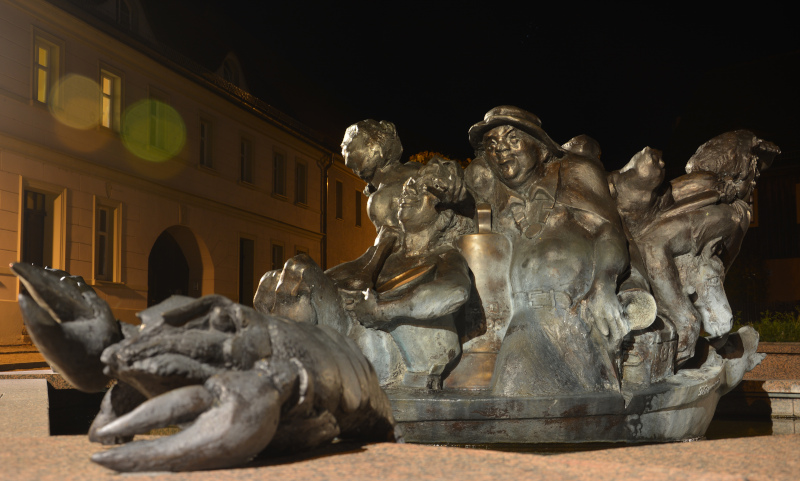
The Schildbürger – Museum also explains a bit about the making of the book and has a whole collection of different editions.
Interesting is beside the museum the Schildbürger – fountain, some meters west down the street. The artist has immortalized in a bronze casting over 20 of the pranks and scenes of the Schildbürger – stories… or hidden 😉 You can spend some time there and will discover more and more details bit by bit. The best thing is to make a list of what you have seen, get the book and try to match the artifacts to the texts. … or vice versa.
Speaking of books… below the Kirchberg (Churchhill) in Goethestraße there is a shop called „Foto Kleber„. When it’s open, it’s worth visiting the shop – there you can get lucky and not only Schildbürger postcards, but maybe one of the Schildbürger books as well. Not the original from 1598, but a revised copy of the Schildau writer Ruth Kraft. Another source for the book can bee the museum.
The Schildbürger – historical background of the Schildbürger – book from 1598
How could it happen that the citizens of the small town Schilda(u) got into disrepute like that? And that the stories of the Schildbürger fill a whole book?
The author is considered to be the provincial nobleman Johannes Friedrich von Schönberg – and he had his manor house and his possessions in : Sitzenroda. The small neighbouring village 3 km east of Schildau. For Schönberg, the unruly citizens of Schildau were a thorn in his eye, because they did not want to simply surrender to his desire for possession. In addition, at the end of the 16th century, the citizens of small country towns also wanted to have their say in the Saxon parliament. But until then the communities were represented by the landed nobles. And so von Schönberg took as his model the Lalebuch, which had appeared shortly before and is little known today, and wrote a diatribe about his free-thinking neighbors. He settled the story in „Misnopotamia“ – which is interpreted as Meissen’s Mesopotamia, that is, between the Elbe and the Mulde. And he also mentions himself, at first encoded in a kind of riddle of letters, and later, from 1603, with the name Bellemont – which cannot be translated otherwise than „Schönberg“.

Also a Schildbürger – Neidhardt von Gneisenau
There is a town hall with particularly large windows (in contrast to the burnt down Schildbürger – town hall) and a monument to Wilhelm Anton August Count Neidhardt von Gneisenau. This general field marshal and army reformer of the Prussian army was born in Schildau in 1760 – and was lost for the first time. During the Seven Years‘ War it was customary that the wives of the officers – pregnant or not – had to travel with the troops. And so Mrs. von Gneisenau gave birth during a rest in Schildau on 27 October.
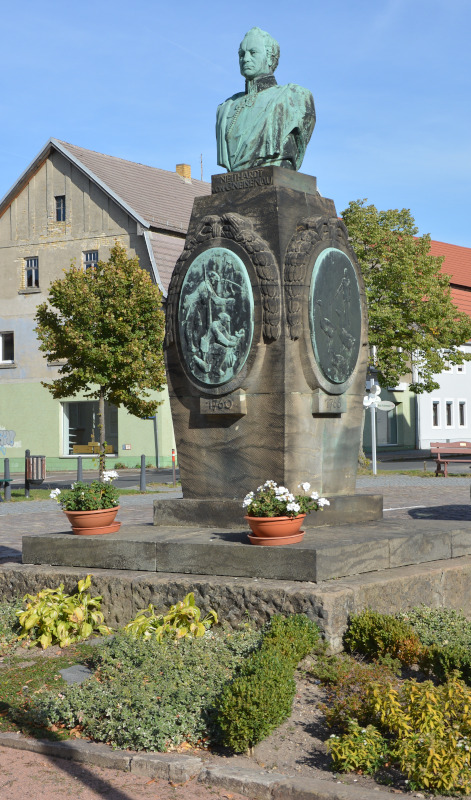
Well, little Neidhardt was baptized in the town church and then it went on soon. But the mother was exhausted and the little boy slipped away on the first kilometre at the edge of town. She did not survive the drama, but the boy was found and brought back to Schildau. There he came to foster parents, who had to struggle with the little blue blood for more than 8 years. The Gneisenaus did not want him back so quickly, so he was used as a human resource and had to look after the Christmas geese of the foster family.

There is a memorial for Gneisenau in the before mentioned „Museum of Schildbuerger“ too.
In Schildau to satisfy the hunger
If you have become hungry now, you can have a look at the market place „To the real Schildbürger„. There you can find typical German dishes, vegetarian (not vegan) on request, if „material for it is available“. The opening hours are a little bit weather-dependent, because opening is only worthwhile if there are enough tourists.
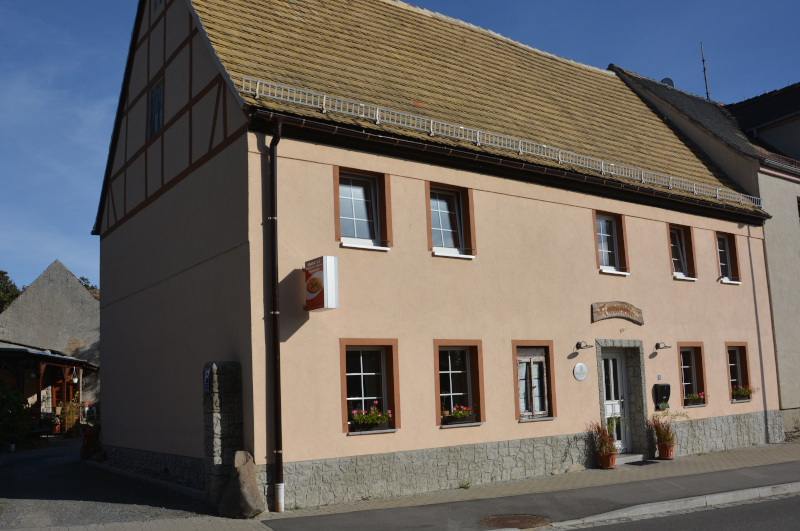
The second, more stylish option is the Indian-Italian „La Cabane„ (former Toscanella Restaurant). From the market over the Kirchberg and then a few more steps to the left into Wurzener Straße. This is open on weekends from 11am -2pm and from 5pm-8pm, Tuesday to Friday only during evening opening hours (Monday is closed). In the colder season the two guest rooms are stylishly heated with fireplace stoves. The walls are mostly unplastered natural stone walls, partly with exposed beams.
In the La Cabane there is mainly pizza, pasta and a selection of Indian dishes. Mostly chicken dishes, but some vegetarian options (possibly even vegan) are also available. In the summer season you can also sit in the backyard.
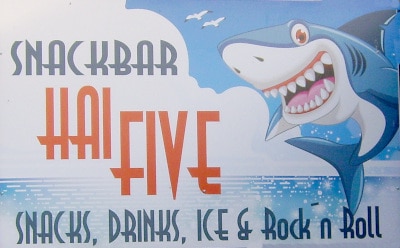
During the summer season (May to August), a snack in the beach bar „Hai five“ at the seaside resort Schildau would be an alternative.
Seebad Schildau – bathing, camping, feeling good
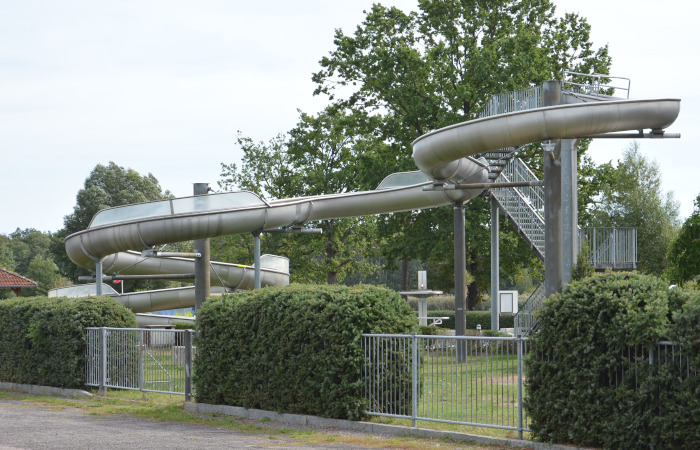
There are overnight accommodation options in Schildau as well – in the town mainly guest rooms. At the seaside resort in the Neumühle district there are two very simple bungalows, the camping site or group accommodation available. These can be reserved at the tourist office of the town or, if still available, booked directly on site at the bath entrance.
For the summer season, the seaside resort on the road to Torgau (approx. 1.5 km north of the town) is therefore a good stopover or an option for a heath weekend. The seaside resort of Schildau is one of the most famous and well-equipped open-air swimming pools in the region – it has a solar-heated „fun pool“ with a long slide, but also a large „nature“ lake for those who prefer to swim a few metres more. On the big lake you can also go out in a rowing boat and look for the sunken Schildbürger bell.
Nature is deliberately written in quotation marks here, as the Neumühlteich, like most ponds in the region, was artificially created centuries ago for fish farming, but has now been well integrated into the natural landscape. It is a resting place and partly also a breeding ground for water birds. To the east is the middle heath as a forest area, where the Kühle-Grund pond still lies and provides a varied forest structure.
Most famous Schildbürger – stories quickly told:
According to the Schildbürgerbuch, the Schildauer Citizens were actually very clever people who were in demand as advisors at courts and government seats everywhere. But at home, house and farm fell into disrepair and the children and servants became rebellious. So they decided to stay at home. They invented all sorts of foolish things to avoid being called up.
Like the Schildbürger who brought in timber for a new town hall. In the Schildberg Forest, trees were felled and carried down. The last trunk slipped from their hands and rolled down. Astonished, they realized that the trees knew their own way – and carried everyone back up the mountain to let them roll.
How the Schildbürger built a new town hall and forgot the windows. New times – new town hall. That is why the building work was done diligently, so that we would soon be able to meet worthily in a new ambience. But – oh dear! In the town hall it was dark like in the darkest night! Something had gone wrong.
How the Schildbürger captured the light. Soon the Schildbürger had the idea that they had forgotten to install the light in the town hall. This could be changed – in the Schildbürger way! They gathered on a sunny noon to catch the light and carry it into the town hall – with baskets, buckets and sacks, even with lasso and mousetrap they tried to bring the light into the house. … unfortunately the success was not too great.
Prudent in tough times 😉
As the Schildbürger sowed salt. Because of troubled times (probably not Corona 😉 ) salt became scarce in the country. So the Schildbürger had the idea to sow their last salt reserves and to meet the shortage with a rich harvest. No sooner said than done, a salt field was planted on the salt hill (Salzberg, which is actually behind the „Toscanella“). And after a short time, strong green plants sprouted – and they burned like salt on fresh wounds if you touched them. But unfortunately the harvest was rather a flop…

How the Schildbürger sank their bell in the lake. A war was coming across the land. So the Schildbürger decided to hide their bell from the armies as an important possession. They took a wooden barge out onto the lake and sank the bell into the water. Where they sank the bell, they made a thick notch in the side of the boat, so that they could later find the bell again…
The final prank is called: As the Schildbürger went out into the world… and ends: .. so today you find people everywhere, who are said to be „That’s a right Schildbürger!“
On way variants from Schildau through the Dahlener Heide to Belgern
If you are not looking for rest and accommodation at the seaside resort, you can continue the cycle tour from Schildau eastwards in the direction of Sitzenroda. The cycle path leads to one of the clay pits from which clay was extracted for the Schildau brickworks until the 1970s. Two or three of them are now valuable wetland biotopes in the field landscape, others were unfortunately filled with building rubble until the 1990s.
Dining in Sitzenroda, horse riding in Taura
In Sitzenroda the beaver den „Zum Biber“ invites you to stay and also to eat, but you should reserve in time. On the menu is often game from the Heide forrests, depending on availability.
From the Belgerner Straße there are several possibilities to dive further into the Dahlener Heide. There is a field path to the left between the buildings of the Christian Social Work in the direction of the heath village Taura.
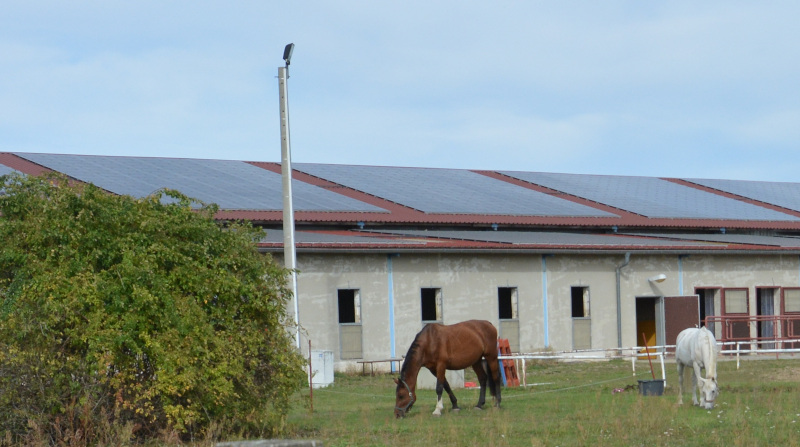
Riding lovers get their money’s worth there – a riding farm „Heideland“ is looking forward to guests who want to explore the heath on horseback. In addition, a holiday park with gastronomy, a garden railway and in autumn usually with a mushroom exhibition is also very attractive. If you are not lucky or have no patience in the wild, you can see some of the region’s animals in the game enclosure. Since one of the forestry offices of „Sachsenforst“ is located in Taura, a forest barn was established as an „environmental educational offer“. This is especially interesting for school groups on project days. If you are interested in a visit, you have to arrange this individually with the forestry office.
Forest, forest, forest…
From Sitzenroda as well as from Taura you can reach Belgern on different ways as the easternmost destination of our exploration of the Dahlener Heide (North).
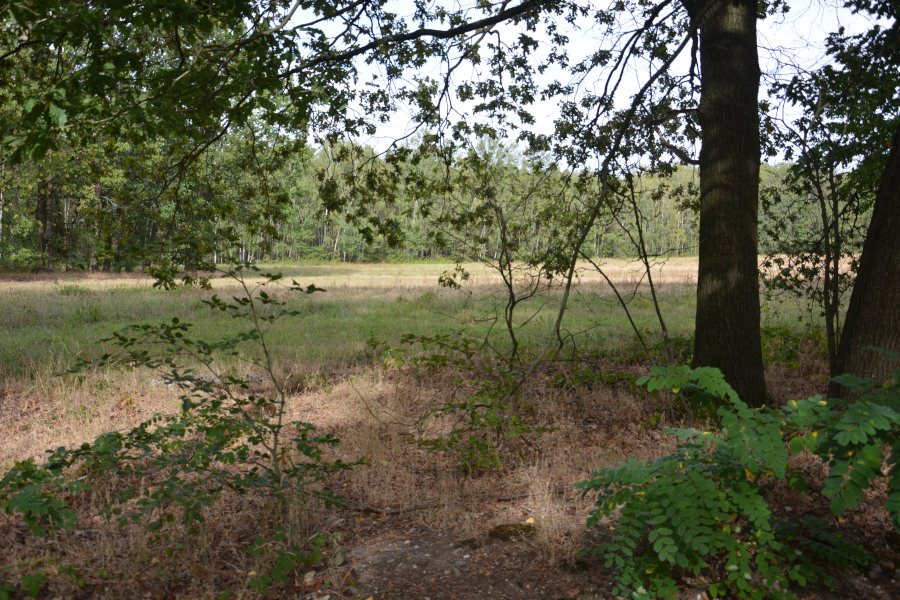
In between there is mainly forest – partly pine forest, partly mixed beech forest, occasionally clearings, ridges of hills, spring valleys and spring ponds… There are no special points in the forest that you should visit in this northern part of the Dahlener Heide. But it is a large, continuous forest area, which is only crossed by a fortified but narrow road. So if you have time and leisure, look for a quiet place and enjoy the seclusion.
Attention – Wolves
Important to know – the Dahlener Heide is Wolf territory! In particular, dogs should be kept on a leash close to humans. Otherwise it can come to fights, which often end deadly for the dogs (competitor). In addition, you must reckon with pests – mosquitoes and ticks. Against the latter I recommend mosquito spray with DEET and in an emergency the tick tongs or card in your first aid kit.
Belgern – the white mountain on the Elbe river
Belgern is then the eastern end of the West-East route through the Dahlener Heide. Here, too, the name of the town has Slavic roots: Bela Gora, the white mountain. Since clay was mined in Belgern, it can be assumed that the name was derived from exposed Kaolin quarries.
Since 2013 united with Schildau in a city union „Belgern-Schildau“, Belgern is situated on a high bank at the river Elbe and thus offers a connection to the Elbe cycle track. So here you have the possibility to continue your bike tour along the Elbe. My recommendation – heading south! Because from Belgern the most beautiful part of the Elbe Cycle Path through the Elbe Valley begins near Meissen, Dresden and Saxon and Bohemian Switzerland. In the opposite direction, from Belgern to Schildau and then on to Wurzen, there is even one of the „official“ connecting links to the Mulder Cycle Path. And in the section from Wurzen to the north, this is much more interesting than the Elbe Cycle Path.
Let’s take the chance and download the Belgern City map via link as .pdf file to discover the place.

Eating ice cream with the Roland von Belgern
In Belgern you can then enjoy an ice-cream sundae in the ice cream café at the market during the summer season. This comes from traditional in-house production of the Gehring family. At the town hall of Belgern there is a Roland as „patron saint“, there is also a „Rolandpark„, where you can find replicas of the Rolande of all other „Roland cities“.
A yaw-rope ferry leads across the Elbe, which allows the continuation of the cycle tour into the Brandenburg area of the Black Elster or on the East Elbe cycle path. By the way, the yaw-rope ferry gets along with the energy of the river. By means of a yaw rope fixed above on the eastern bank and a variable rope triangle on the ferry itself, the ferryman can place the boat body at an angle against the current so that the ferry, drifting on the rope, reaches the other bank. This way the ferry can bring several cars or even combine harvesters and tractors up to 30 tons over the river.
Above the Elbe ferry Belgern on the access road to the town center, the restaurant „Fährdiele“ invites tired cyclists from the Elbe cycle path and other guests to take a break. Since 2021 a new host has taken over the inn, the menu of the Fährdiele Belgern is much more varied. Vegetarians also get their fill. In the after-work chat, the host assured me that he is certainly open to a rich vegetarian offer and tries to offer as many regional organic products as possible. Which goes and which not, decide however finally the guests with their menu choice. It remains to be hoped that such a commitment, which is unfortunately not a matter of course everywhere in rural areas, will be rewarded by happy customers.
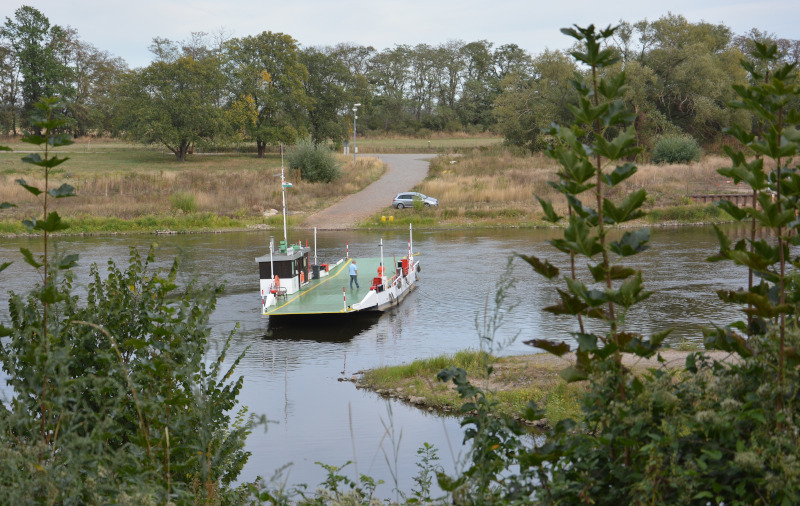
Elstermeadows, Elbe- Cycle path or southern Heathland – where do you go from here?
Belgern offers accommodation in several guesthouses, which are mainly used by the cycle tourists on the Elbe cycle path. So there are various options for continuing the cycle tour after one (or even two) exciting days in the northern part of the Dahlener Heide and quarters in Belgern: In the southern part of the Dahlener Heide with Schmannewitz and Dahlen, on the Elbe Cycle Path north for example to Dessau – Wörlitz Garden Estate or with the ferry across and on in Brandenburg
Schildau – Belgern cycle tour video
How is tired to read so much can join now the cycle tour from Schildau to Belgern at the Elbe river in a little video clip:
Travel tips for the northern Dahlener Heide
Some hints are already included in the current article. Here are some more tips for the organisation of your tour through the northern Dahlener Heide like travel, accommodation, literature and maps.
Additional hints for your journey
The next airport to the Dahlen Heath region is Leipzig – Halle (LEJ) There you can get full service with train station or car rental service.
As described, the journey by train* is easily possible. Also and especially by bike, which you will need especially on weekends because of the limited traffic with local bus connections. The S4 from Leipzig provides the fastest connection to this region. Bicycles can be carried free of charge in the Mitteldeutsche transport association (MDV) in the train.
With your own car, a rental car* or a camper van* you can reach the northern Dahlener Heide from the A14 motorway via the B87. Alternatively, you can take the B6 to Wurzen and from there on the state road 23 to Schildau.
Accommodation in the northern Dahlener Heide
I have already mentioned the castle hotel in the manor in Kobershain*. On offer are an apartment for two persons and a family suite with double bed and two single beds. A kitchenette belongs to each apartment. Breakfast is offered with every overnight stay. Pets are allowed. Shopping facilities in Schildau.
In the middle of the heath, in the heath village Lausa you will find the small holiday cottage Pension Lausa*. In this bungalow up to 4 persons can sleep in two bedrooms. A complete kitchen equipment makes a longer stay possible. However, you have to bring your own supplies – Lausa does not have its own markets. The nearest supermarkets are in Schildau or Belgern. Pets are welcome.
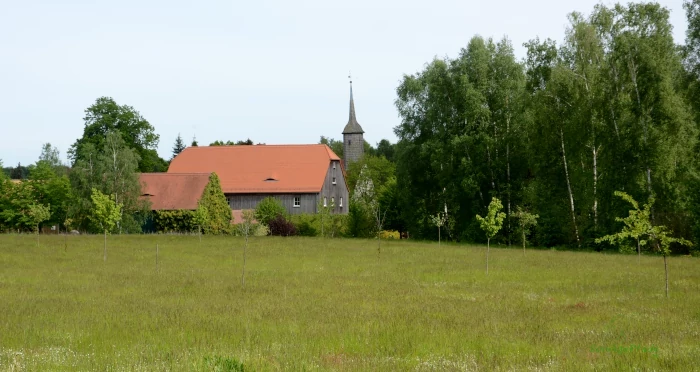
Accomodation in the east near the Elbe river
There is room for up to five people in the holiday home Fuxbau*. This is located on the edge of the heath in Wohlau. Three bedrooms also allow a quiet stay for families with several children. A kitchen is available. There is a pool in the garden. Deck chairs invite you to sunbathe. Bicycles can be rented for a fee. Horse riding tours can be arranged. Pets are allowed.
Another possibility to stay overnight in Wohlau is the holiday home Weitblick*. There is room for 4-5 persons on 130 sqm. (2x bedroom with double bed, a sofa bed in the living room). A garden with outdoor pool and children’s playground belongs to the property.
From Wohlau the Elbe bridge into the Brandenburg Mühlberg is not too far away.
In Neußen on the eastern edge of the heathland forests, the spacious Kraußnitzbach holiday apartment* awaits you. A kitchen with oven and dishwasher allows for extensive self-catering. In the bedroom two persons can sleep in a double bed, two more persons find room on the sofa bed in the living room. In the garden you can barbecue. There are shopping possibilities in Belgern. Pets are not allowed here.
Also in Neußen you can use the holiday flat Lipizzaner*. With a double bed in the bedroom and a sofa bed up to 3 persons can be accommodated. The garden at the house offers a barbecue possibility. Pets are allowed here.
On the eastern side of the Elbe river, 2 persons each find accommodation in two apartments in Triestewitz Castle*. You have to cross over in Belgern with the ferry. This is a good starting point to continue on the eastern Elbe cycle path or to change to Herzberg in Brandenburg. Then swimming in the Kiebitz Lake near Falkenberg/ Elster, 12 km away, is an option. Breakfast is included in the overnight stay. Otherwise self-catering is possible in the kitchens of the apartments, but you have to bring your own supplies.
Riding and horse driving in the northern Dahlener Heide
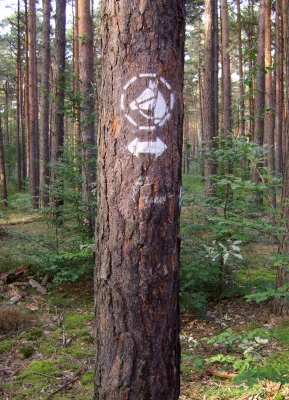
Several equestrian or horse farms offer the possibility of horseback riding vacations or creemer rides in the region. Already mentioned the equestrian farm in Taura. Another opportunity is offered by the equestrian farm Familie Scharf in Sitzenroda. (Zum Quellental 42, unfortunately no web-site, Tel. 034221 5 03 23)
In addition to bike paths and hiking trails, there is also an extensive network of riding trails in the Dahlener Heide. These run only partly on the paved paths – often the bridle paths are somewhat overgrown aisles, on which at least cyclists tend not to travel. A map of the horse trails in the Dahlener Heide can be downloaded as a .pdf – file here.
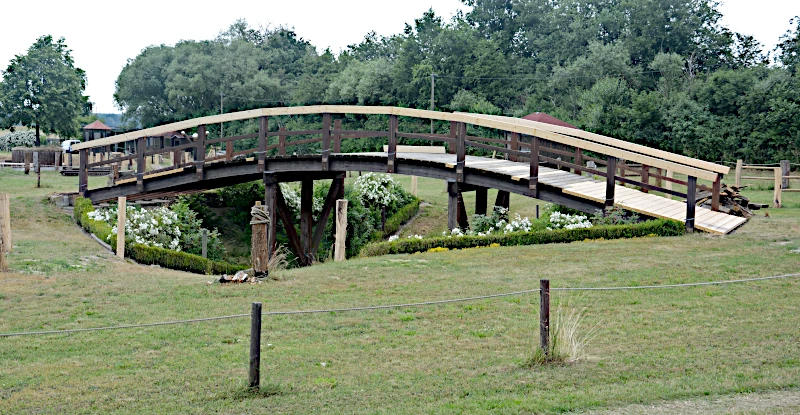
In Schildau horse driving sport of the extra class is offered. Namely on the Carriage Horse – Driving Arena „Pferdesport Arena“ on Sitzenrodaer Street. This driving sport facility is several times a year venue for competitions partly up to German championships or qualification runs for world championships. In addition, 2022 there are again horse sport events as a competition on the „Schildbürger – distance“.
The 2020 cancelled because of Corona conditions world championship of the Para drivers took place now of 06.- 08. August 2021 on the carriage horse driving arena in Schildau.
The special feature of the Horse – Driving facility in Schildau is the connection with the Schildbürger tales: the obstacles were designed as a setting for Schildbürger pranks and replicas of Schildau buildings. In the surrounding area, as a supplement to the obstacle rides, cross-country tests and other horse driving competitions, as well as equestrian events, take place. The „distance – driving“ in the woods between Schildau and Ochsensaal enjoys increasing popularity. The shooting guild as the operator is a regular guest at the Leipzig fair „Partner Pferd“ (Partner Horse) with the model of the „Pferdesport – Arena Schildau“ (Carriage Horse – Driving facility Schildau).
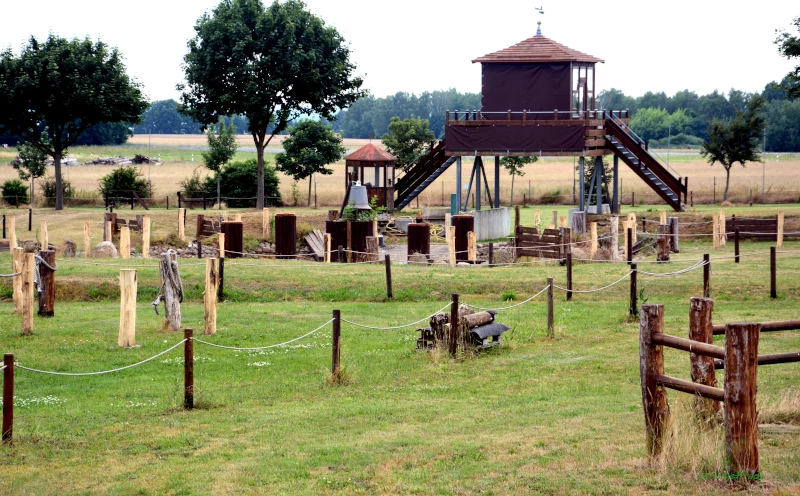
Events 2025 in the Carriage Horse – Driving arena of Schildau
2 to 4 May 2025 Schildbürger – Distance:
Endurance riding (also for children) as well as carriage driving, with international participation.
29 – 31 August – 01 September 2025 Midle german Four-in-hand – Championship Teamdriving in Carriage horse driving:
Team carriages in the Horse – driving arena (dressage, steeplechase, cross-country driving).
The Schildauer Privilegierte Schützengilde (traditional Rifle club -roots back to 1542- with horse riding and carriage driving extention) as the organizer is also represented with a stand at the Leipzig fair „Partner Pferd“ (Partner horse) from 18 to 21 Januaryl 24. Among other things, a model of the Schildau horse driving arena will be on display there. Who participates in the lottery, has the chance on free tickets to the world championship qualification – competitions in the carriage horse- driving arena.
Hiking maps for Dahlen heathland
To get a fast survey about Dahlener Heide, you can download the .pdf via the web-link.
The best map for the region is the cycling and hiking map Dahlener Heide*, Wermsdorfer Wald and surroundings published by A.Barthel Verlag. It contains an overview and information on a scale of 1:50,000.
With the scale 1:125.000 less detailed is the „Excursion map Leipzig and surroundings*“ from the same publisher. This map provides an overview of several interesting areas in the Leipzig area and offers suggestions for „small escapes“ on weekends and short holidays.
If you want to continue on the Elbe Cycle Path in Belgern or explore the Dahlener Heide region on a tour on the Elbe Cycle Path, you are on the right track with the cycle tour map „Elbe Cycle Path 1: Bad Schandau – Dessau „*.
Curious about a Schildbürger – weekend?
Then share the link to the article via your social media channels, invite your friends and tell your adventures from the Dahlener Heide in the comments! I am happy about nice experiences – reports!
At least as a little summary the FAQ:
Stories of the Schildbuerger are comparable with the „Wise men of Gotham“ in Gotham, Nottinghamshire – UK. The Schildbuerger were citizens of the legendary town of Schilda, who became known for all sorts of fool – pranks such as : building a town hall without windows, carrying light into the town hall, sowing salt, sinking a bell in the lake and marking the spot with a notch in the boat’s edge, sentencing a crab to death by drowning, etc. Actually, they were clever people, but tired of the constant visits to emperors and kings as advisors, they shifted to Folly, in order to be able to stay in peace back in Schilda.
In the Schildbuerger book the location of Schilda is described with „in Misnopotamia„, thus the Meissen Mesopotamia in East Germany. Therefore it is assumed today that Schildau is the city of the Schildbuerger, which lies between Elbe and Mulde rivers north of Meissen in North Saxony. Especially since the family of the author of the Schildbürgerbook, Friedrich von Schönberg (Nice mount), was at home in the village Sitzenroda – and that is only 3km away from Schildau. The writer refers to himself in the book as „Bellemont„. Schildau is located about 50km east of Leipzig on the western edge of the Dahlener Heide.
Even though Schildbuerger pranks are best known in the German-speaking world, similar stories exist in more regions and countries. The model for the German Schildbuergerbook of 1598 is the Lalebuch of 1597, written in Swabian only a short time before, printed in Strasbourg (and far less common). Well known in Teterow in Mecklenburg (north of East Germany) is, for example, the pike saga – a variant of the sunken bell story. In the Czech Republic, the Moravian Schildberg, today Śtíty, is known as Schildbürger – place. Even in other cultural circles, for example in the Eastern Jewish tales of the Chelm Fools or in Turkey with Hodscha Nasreddin, similar tales can be found. In England, the „Wise Men of Gotham“ are comparable to the Schilda Citizens.
The Schildbürgerbook was written by the nobleman Johann Friedrich Schönberg, who refers to himself as „Bellemont“ in the introduction to the book. The Schönberg family lived in Sitzenroda in East Germany, 3 km east of Schildau. Bellemont was probably enraged that the citizens of Schildau resisted his appropriation and that the citizens of country towns no longer wanted to be patronized by the nobility.
Pranks of the Schildbuergers are the antics of the citizens of Schilda, which are described in the German Schildbürgerbook. So – carrying light to the town hall, carrying tree trunks back up the hill only to have them roll down, mistaking a crab for a tailor and then sentencing it to death by drowning, dragging a cow up a wall by a rope to have it graze the top of the wall. Today in Germany as Schildbuerger pranks are often called decisions in politics and economics, which correspond formally to right and law, but appear practically nonsensical and out of touch with life.
The Schilda citizens were actually clever people and were employed everywhere by kings and princes as advisors. As a result, the houses and stables at home fell into disrepair, the servants became rebellious, and the children were naughty. The Schilda citizens discussed how to get rid of their duties in foreign countriesand Kingdoms and came up with the idea of playing dumb. As a first sign of their wise decision they built a new town hall – triangular and without windows…
The Roland town of Belgern is located in northern Saxony on the Elbe River in East Germany, about 65 km east of Leipzig on the eastern edge of the Dahlener Heide (Dahlen heathland).
In Belgern there is the Elbe ferry, a yaw rope – ferry, which is driven by the current of the Elbe. With it, pedestrians, cyclists and motorists can cross the Elbe in the direction of Arzberg.
* Advertising note
Some links in this article are marked with *. These are so-called affiliate links. If you click on the link and buy or book something in the connected store, the sonnige pfade blogg will get a small commission to build this blog. Nothing will be more expensive for you, because the commission has already been taken into account in the pricing.
